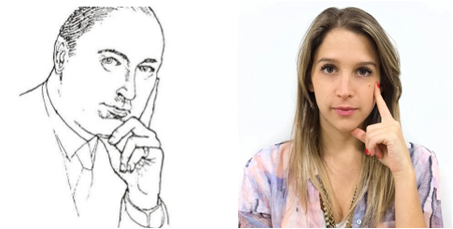In the previous issues we learned the different types of hand-to-mouth gestures and how to interpret each of them.
If you want to know their interpretations and have not yet seen, I invite you to read them in the following links:
https://steemit.com/life/@aitosaya/what-we-should-know-tips-body-language-chap-5part-1
https://steemit.com/life/@aitosaya/what-we-should-know-tips-body-language-chap-5part-2
For the moment, we will bow in this section, to know about some gestures that usually appear with hands on the cheeks and chin.
Gestures with the Cheeks and the Chin
1.- Support the head with the hand
They are signs of boredom presented by listeners.
The degree of boredom is directly proportional to the strength with which the arm and hand hold the head. For this reason, the maximum degree of boredom and disinterest is manifested when the head is fully supported by the hand.
Additionally, signs such as hitting the table with the fingers and the floor with the feet are usually interpreted by the speakers as a symbol of boredom. However, the truth is that they are signs of impatience, where the frequency of tapping is proportional to the degree of impatience; that is, the faster these taps occur, the more impatient the person is.

Source 1|Source 2
2.- Support the cheek with the closed hand
This position is shown as Evaluation and is often accompanied with index finger upwards.

Source 1|Source 2
The gesture of the index finger pointing upwards on the cheek and thumb supporting the chin indicates that the listener is having negative or critical thoughts about the speaker or about the subject under discussion.
If critical thinking continues, the index finger will slide towards the eye. And this is how the time someone maintains this position is indicative of how critical their attitude is. Often, this gesture is often confused with the sign of interest, but the use of the thumb is evidence.

Source 1|Source 2
It is important to keep in mind that genuine interest is expressed when the hand is resting on the cheek and not the head in the palm.
This signal is indicative that the person is making a decision when the gestures have changed from the evaluation to the decision making; where, the later movements will indicate if the decision is positive or negative.

Source 1|Source 2|Source 3|Source 4
For example:
- If a Client leans back in the seat and crosses the arms and legs after having stroked his chin, he is telling the seller non-verbally, "I will not buy your product".
- If the Client adopts a "be prepared" position, it represents a positive decision for the seller; that is, the customer wants to make the purchase.
EThere are occasions in which the gestures seen in this section can be combined; that is, gestures of: boredom, evaluation and decision, and each of these gestures is an element of the person's attitude.
The gesture of evaluation can be transformed into the one of caressing the chin. Which implies that the person is judging and making a decision at the same time.
When the listener begins to lose interest, he begins to rest his head in his hand; that is, the evaluation gesture is transformed to that of the head supported on the thumb.
____________________________________________________________(To be continue)